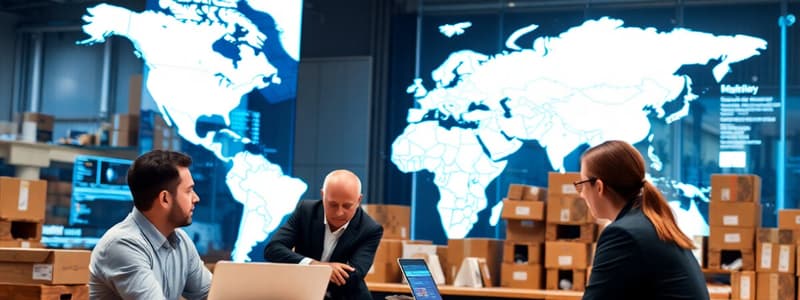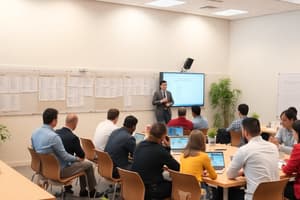Podcast
Questions and Answers
What distinguishes a global organization from a domestic one?
What distinguishes a global organization from a domestic one?
- It operates and competes in more than one country. (correct)
- It exclusively uses advanced technologies.
- It focuses solely on exporting goods.
- It only hires employees from its home country.
Which element is NOT a direct component of the task environment?
Which element is NOT a direct component of the task environment?
- Distributors
- Economic forces (correct)
- Suppliers
- Customers
Why might relying on a single distributor pose a threat to an organization?
Why might relying on a single distributor pose a threat to an organization?
- It may result in a lack of control over the distributors.
- It decreases logistical costs.
- It increases the number of channels to sell products.
- The distributor may control most of the customers and charge high costs. (correct)
When organizations consider the general health and well-being of a nation or regional economy, they are analyzing:
When organizations consider the general health and well-being of a nation or regional economy, they are analyzing:
How do 'political and legal forces' primarily influence organizations?
How do 'political and legal forces' primarily influence organizations?
What is the primary driver of globalization according to the provided content?
What is the primary driver of globalization according to the provided content?
Which form of capital refers to the flow of money across world markets through investments?
Which form of capital refers to the flow of money across world markets through investments?
What is a key factor that has increased the rate of capital flows between companies and countries?
What is a key factor that has increased the rate of capital flows between companies and countries?
According to Hofstede's dimensions of national culture, what does 'power distance' refer to?
According to Hofstede's dimensions of national culture, what does 'power distance' refer to?
Which characteristic is typical of cultures with high uncertainty avoidance?
Which characteristic is typical of cultures with high uncertainty avoidance?
What is the primary focus of 'feminine' cultures, according to Hofstede's model?
What is the primary focus of 'feminine' cultures, according to Hofstede's model?
What does a high score in the 'indulgence' dimension of national culture suggest?
What does a high score in the 'indulgence' dimension of national culture suggest?
What is the defining characteristic of programmed decision making?
What is the defining characteristic of programmed decision making?
What is 'reasoned judgment' in the context of decision-making?
What is 'reasoned judgment' in the context of decision-making?
What does the 'classical decision-making model' assume?
What does the 'classical decision-making model' assume?
Which factor is a characteristic of the 'administrative model' of decision making?
Which factor is a characteristic of the 'administrative model' of decision making?
What is the meaning of 'satisficing' in the context of decision-making?
What is the meaning of 'satisficing' in the context of decision-making?
Which of the following is a potential disadvantage of group decision-making?
Which of the following is a potential disadvantage of group decision-making?
What is the purpose of 'Devil's Advocacy' in decision-making?
What is the purpose of 'Devil's Advocacy' in decision-making?
Which technique involves group members writing down ideas and solutions individually, then sharing them with the group for discussion?
Which technique involves group members writing down ideas and solutions individually, then sharing them with the group for discussion?
Flashcards
What is a global organization?
What is a global organization?
An organization that operates and competes in more than one country.
What is the global environment?
What is the global environment?
Forces and conditions from outside an organization that affect its behavior.
What is task environment?
What is task environment?
Forces that originate with suppliers, distributors, customers, and competitors, affecting the organization's ability to obtain inputs and dispose of outputs.
Who are distributors?
Who are distributors?
Signup and view all the flashcards
Who are customers?
Who are customers?
Signup and view all the flashcards
Who are competitors?
Who are competitors?
Signup and view all the flashcards
What is the general environment?
What is the general environment?
Signup and view all the flashcards
What are economic forces?
What are economic forces?
Signup and view all the flashcards
What are technology forces?
What are technology forces?
Signup and view all the flashcards
What are sociocultural forces?
What are sociocultural forces?
Signup and view all the flashcards
What are demographic forces?
What are demographic forces?
Signup and view all the flashcards
What are political and legal forces?
What are political and legal forces?
Signup and view all the flashcards
What is globalization?
What is globalization?
Signup and view all the flashcards
What is human capital?
What is human capital?
Signup and view all the flashcards
What is financial capital?
What is financial capital?
Signup and view all the flashcards
What is resource capital?
What is resource capital?
Signup and view all the flashcards
What is political capital?
What is political capital?
Signup and view all the flashcards
What is decision making?
What is decision making?
Signup and view all the flashcards
What is programmed decision making?
What is programmed decision making?
Signup and view all the flashcards
Non-programmed decision making?
Non-programmed decision making?
Signup and view all the flashcards
Study Notes
- A global organization operates and competes in more than one country, examples include Coke, Google, and Apple.
- Operating globally can be unpredictable, but offers opportunities in new markets, technologies, and lower raw material costs, while threats from new competitors also exist.
- The global environment consists of external forces/conditions that affect an organization's operations and behavior.
Task Environment and Forces
- The task environment includes forces and conditions originating with suppliers, distributors, customers, and competitors.
- It affects an organization's ability to obtain inputs and dispose of outputs, influencing managers daily.
- These forces have the most immediate and direct impact on managers.
Suppliers
- Suppliers provide resources for goods and services through outsourcing.
- Managers ensure a reliable supply of input resources.
- Suppliers being the sole source of input or the input being vital to the organization are challenges. Increasing opportunities from many suppliers for a particular input including outsourcing can lower costs.
Distributors
- Distributors help organizations sell goods or services to customers.
- More channels to sell products creates opportunities.
- Distributor control over customers can lead to high costs, acting as a threat.
Customers
- Customers are those who buy goods and services
- Opportunities arise with new customers.
- Threats involve identifying and satisfying customer needs.
Competitors
- Competitors are organizations offering similar goods and services.
- More competitors and potential competitors are threats, reducing profit with barriers to entry.
General Environment and Forces
- The general environment encompasses a wide range of global, economic, technological, sociocultural, demographic, political, and legal forces.
- These forces affect both an organization and its task environment.
Economic Forces
- Economic forces include interest rates, inflation, unemployment, economic growth, and other factors.
- They affect the general health and well-being of a nation's or region's economy.
Technological Forces
- Technological forces are outcomes of changes in design, production, and distribution technologies.
Sociocultural Forces
- Sociocultural forces are pressures from a country or society's social structure or national culture. Social structure involves traditional systems between people and groups in society and national culture involves values important to society's norms.
Demographic Forces
- Demographic forces are outcomes of changes in population characteristics or attitudes, like age, gender, ethnic origin, race, sexual orientation, and social class.
Political and Legal Forces
- Political and legal forces are outcomes of changes in laws and regulations.
- These include industry regulations, organizational realization, and increased emphasis on environmental protection.
Globalization
- Globalization integrates and connects economic, political, and social systems across countries, cultures, and regions, making nations increasingly interdependent and similar.
- Globalization is shaped by the ebb and flow of capital, seeking the greatest returns or profits across companies, countries, and regions.
Four Principal Forms of Capital
- Human capital is the flow of people worldwide through immigration, migration, and emigration.
- Financial capital is the flow of money across world markets through overseas investments, credit, lending, and aid.
- Resource capital is the flow of natural resources, parts, and components between companies and countries.
- Political capital is the flow of power and influence using diplomacy, persuasion, aggression, and force to protect rights or access.
Factors Increasing Capital Flows
- Declining barriers to trade and investment, including tariffs, increase capital flow.
- Declining barriers of distance and culture also promote capital flows.
Hofstede’s Model of National Culture
- This model helps to understand cross-cultural differences.
Power Distance
- This refers to the degree to which less powerful members of an organization accept unequal power distribution.
Achievement orientation
- This relates to the importance placed on achievement and competition.
Individualism/Collectivism
- Individualism/collectivism involves expectations regarding self-reliance versus integration into groups.
Studying That Suits You
Use AI to generate personalized quizzes and flashcards to suit your learning preferences.




